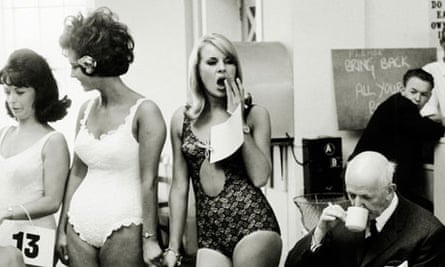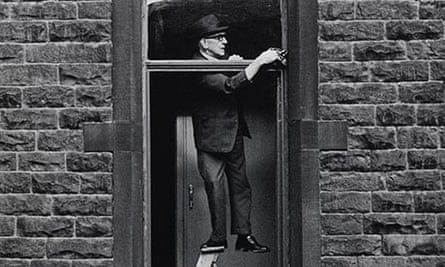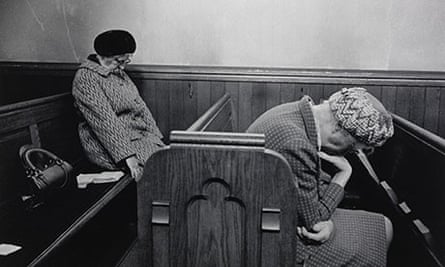After much delay, the anticipated Media Space has finally opened in Kensington, with Only in England, a retrospective exhibition devoted to the great British documentary photographer Tony Ray-Jones, and a show of early black-and-white work by Martin Parr. Though it seems odd to open a new photography space, and one attached to the Science Museum, with a show of bygone photography, it is great to finally see a major retrospective of Ray-Jones's work, while the Parr show will be a revelation to those who only know his in-your-face colour photography.
First, though, a word about the gallery design. The 525 square metres of space make it one of the biggest venues for photography in Britain, even if it will not be exclusively devoted to the medium. The main space, designed by Ben Kelly, has walls on wooden frames that run down the centre, suggesting a gallery within a gallery. Though this could give the impression of an unfinished project, the design certainly increases the wall space.

The photographs are the thing, though, and Greg Hobson, curator of photographs at the National Media Museum in Bradford (from where these prints were selected) has created an excellent overview of Ray-Jones's life and work.
The first part of the show comprises 61 vintage prints from the late 1960s. Then you enter Parr's section, which consciously shows his debt to Ray-Jones, and finally you reach a room in which Parr has selected 56 lesser-known Ray-Jones pieces to further emphasise their connection. More intriguing still is the ephemera – notebooks, layouts and lists – in vitrines and on the walls.
On one such list, Ray-Jones wrote simply "DO NOT TAKE BORING PHOTOGRAPHS". He didn't. Nor was he a boring presence, but rather a singular and sometimes combative one. He once famously introduced himself to the editor of Creative Camera magazine with the words "Your magazine's shit". His self-confidence was honed in the US, where he studied at Yale and attended the Design Lab run by the great art director Alexey Brodovitch in the early 60s in Richard Avedon's studio. On his return to London in 1965, Ray-Jones began photographing his abiding subject: the English at play. The street and the seaside were his main stomping grounds, but he also photographed the essentially English rituals of Eton boarding school and the Glyndebourne opera festival, as well as beauty contests and pop festivals.
Ray-Jones was in many ways a social anthropologist with a camera, but it is his eye for detail and often brilliantly complex compositions that sets him apart. His images often appear cluttered: in Brighton Beach, 1969, a man pushes a stuffed bear on wheels, while a row of seated men turn to watch; there are railings in the foreground and a stretch of pier in the distance. On closer inspection, though, what we are glimpsing is several small narratives contained in the bigger defining one.
At the Isle of Wight music festival in 1969, he photographed bedraggled hippies on the ferry and audience members perched precariously up trees straining for a glimpse of Bob Dylan, whose presence is only hinted at. Today, the hippies seem as oddly English as the dog lovers he captures at Crufts or the bored girls lining up for inspection at a beauty contest in Scarborough. In his photographs, the recent English past does indeed seem like another country, but one that, for all the strangeness he captures, remains oddly familiar. Tony Ray-Jones died in 1972, aged 30, of leukaemia, but in his short life he helped create a way of seeing that has shaped several generations of British photography.

In this light, it is doubly interesting to look at Martin Parr's series, The Non-Conformists, made in and around Hebden Bridge, Yorkshire in 1975, just after he graduated from art school. The title comes from the Methodist and Baptist churches that dotted the region and defined its communal character back then.
It's easy to forget how quietly observational Parr was as a black-and-white photographer. There are scenes here in which you can almost feel the silence of a particularly English puritanical form of worship: severe-looking men and women seated in pews intent on their hymnals and bibles; a woman spooning sugar into her teacup beneath a grotesque painting of the Last Supper. There is unlikely drama, too: in one surreal shot, a young boy with a toy machine gun sprays imaginary bullets at an outdoor congregation from behind a plinth. In another, a besuited and bespectacled man holds up a single cabbage in a harvest auction.

Parr captures this world of worship in such telling detail that it may make you question everything you thought you knew about his work, and how he arrived where he is today. The influence of Ray-Jones is apparent here and there, but this is someone who had already found his own perception of the world.
Together, these complementary exhibitions provide an endlessly revealing look back at a pivotal moment in British documentary photography. Next time around, though, let's have something bold and contemporary that looks at the vitality and confusion of photography in the fast-forward digital age. Media Space is part of the Science Museum, after all.

Comments (…)
Sign in or create your Guardian account to join the discussion